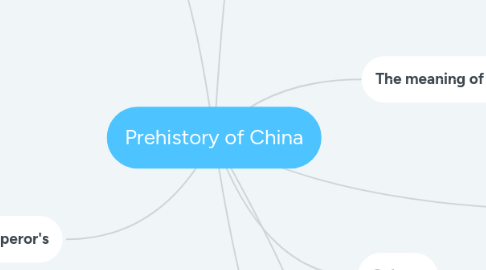Prehistory of China
by Rafa Nayaka Hadiatno


1. Metal age
1.1. Chinese starts and in ranged from the xia dynasty to shang dynasty and to zhou dynasty.The Bronze Age was a period when the Three Wise Kings and Five August Emperors lived, and their name is Suiren, Shennong, Fuxi, Huangdi, Zhuanyu, Yao the Great, Shun and Yu The Bronze culture reached its peak time in the Zhou Dynasty (1046 BC-221 BC), and a large number of bronze wares have been unearthed by archeologists, on which inscriptions were carved.
1.2. The Bronze Age was the time when men learned how to mine and smelt copper and tin to make bronze weapons and tools. These activities required an organized labor force and skilled craftsmen. In Neolithic times (before the Bronze Age), people had made tools out of stone and hunted and gathered their food. However, in the Bronze Age people learned how to farm and produce enough extra food to feed other workers such as miners, bronze-smiths, weavers, potters and builders who lived in towns and to feed the ruling class who organized and led society.
1.3. The Chinese Bronze Age had begun by 1700 B.C. in the kingdom of the Shang dynasty along the banks of the Yellow River in northern China. At times the Shang kings ruled even larger areas.
2. Emperor's
2.1. The Bronze Age was a period when the Three Wise Kings and Five August Emperors lived, and their name is Suiren, Shennong, Fuxi, Huangdi, Zhuanyu, Yao the Great, Shun and Yu The Bronze culture reached its peak time in the Zhou Dynasty
3. The Neolithic period began in China about 12,000 B.C. However, good evidence of Neolithic settlements exists from only about 4,000 B.C. The Neolithic lasted until about 2,000 B.C.
4. The meaning of prehistoric
4.1. Prehistoric means describing a time that is record or written.
5. Stone age
5.1. Early people made it to China about 700,000 years ago. They were Homo Erectus, and maybe some Denisovans. One example is “Peking Man”.They had dark skin and wide flat noses. These people lived in caves. They made fires and used stone tools.
5.2. During the Shang Dynasty (1600 BC-1046 BC) to the Eastern Zhou Dynasty (1050 BC-256 BC), China went into a flourishing period for steel smelting. In the Han Dynasty (202 BC-220 AD), private-enterprise iron-making was abolished and was monopolized by the state, creating an iron-smelting bloom
5.3. Another big change happened around 8000 BC, in the Neolithic or New Stone Age. People started to farm rice and millet as their main foods. Another big change happened around 6000 BC when people in China started to keep animals
6. Culture
6.1. Buddhism is the most important religion in China. It is generally believed that it was spread to China in 67 AD during the Han Dynasty (206 BC-220) from Hotan in Xinjiang to Central China. During its development in China, it has a profound influence on traditional Chinese culture and thoughts, and has become one of the most important religions in China at that time.
6.1.1. In the Chinese language the word tao means "way," indicating a way of thought or life. There have been several such ways in China's long history, including Confucianism and Buddhism

